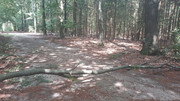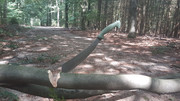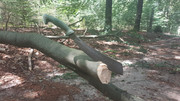Currently busy finetuning two Condor choppers, a Bushcraft Parang and an Eco Golok machete.
For years i've only used kukri models for trail clearing (a Tora Blades Camping kukri and a Cold Steel Kukri machete) here on the Veluwe, and the plan is to get some hands-on experience using a few other tried & true chopping blades from different parts of the world.
Just did the contouring & fuzzy/chewy finishing of the Golok machete handle with the wood rasp (the Parang will get the same treatment), and tested the blade on a few thick dried oak branches and various green stuff.
Very well hardened 1075 steel i must say (no visible flattening or rolling at +/- 30 degrees inclusive), and now the handle is much more comfortable and grippy compared to the thick and slick factory handle (for my hands anyway)
Also no need for additives like grip tape etc.
The Eco Golok machete has a more V-shaped edge, while the Bushcraft Parang has a medium high convex edge with an apex around 40 degrees.
Both will later get a convex edge with an apex around 30 degrees inclusive.




For years i've only used kukri models for trail clearing (a Tora Blades Camping kukri and a Cold Steel Kukri machete) here on the Veluwe, and the plan is to get some hands-on experience using a few other tried & true chopping blades from different parts of the world.
Just did the contouring & fuzzy/chewy finishing of the Golok machete handle with the wood rasp (the Parang will get the same treatment), and tested the blade on a few thick dried oak branches and various green stuff.
Very well hardened 1075 steel i must say (no visible flattening or rolling at +/- 30 degrees inclusive), and now the handle is much more comfortable and grippy compared to the thick and slick factory handle (for my hands anyway)
Also no need for additives like grip tape etc.
The Eco Golok machete has a more V-shaped edge, while the Bushcraft Parang has a medium high convex edge with an apex around 40 degrees.
Both will later get a convex edge with an apex around 30 degrees inclusive.












































